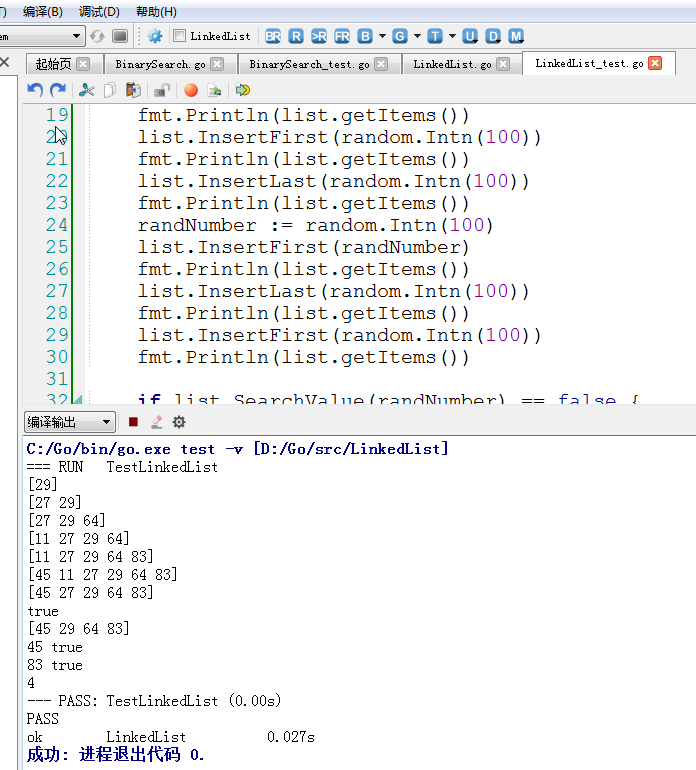golang数据结构和算法之LinkedList链表
差不多自己看懂了,可以自己写测试了。:)
LinkedList.go
package LinkedList
//"fmt"
type Node struct {
data int
next *Node
}
type LinkedList struct {
head *Node
}
func (list *LinkedList) InsertFirst(i int) {
data := &Node{data: i}
if list.head != nil {
data.next = list.head
}
list.head = data
}
func (list *LinkedList) InsertLast(i int) {
data := &Node{data: i}
if list.head == nil {
list.head = data
return
}
current := list.head
for current.next != nil {
current = current.next
}
current.next = data
}
func (list *LinkedList) RemoveByValue(i int) bool {
if list.head == nil {
return false
}
if list.head.data == i {
list.head = list.head.next
return true
}
current := list.head
for current.next != nil {
if current.next.data == i {
current.next = current.next.next
return true
}
current = current.next
}
return false
}
func (list *LinkedList) RemoveByIndex(i int) bool {
if list.head == nil {
return false
}
if i < 0 {
return false
}
if i == 0 {
list.head = list.head.next
return true
}
current := list.head
for u := 1; u < i; u++ {
if current.next.next == nil {
return false
}
current = current.next
}
current.next = current.next.next
return true
}
func (list *LinkedList) SearchValue(i int) bool {
if list.head == nil {
return false
}
current := list.head
for current != nil {
if current.data == i {
return true
}
current = current.next
}
return false
}
func (list *LinkedList) GetFirst() (int, bool) {
if list.head == nil {
return 0, false
}
return list.head.data, true
}
func (list *LinkedList) GetLast() (int, bool) {
if list.head == nil {
return 0, false
}
current := list.head
for current.next != nil {
current = current.next
}
return current.data, true
}
func (list *LinkedList) GetSize() int {
count := 0
current := list.head
for current != nil {
count += 1
current = current.next
}
return count
}
func (list *LinkedList) getItems() []int {
var items []int
current := list.head
for current != nil {
items = append(items, current.data)
current = current.next
}
return items
}
LinkedList_test.go
package LinkedList
import (
"fmt"
"math/rand"
"testing"
"time"
)
func TestLinkedList(t *testing.T) {
random := rand.New(rand.NewSource(time.Now().UnixNano()))
headNode := &Node{
data: random.Intn(100),
next: nil,
}
list := &LinkedList{
head: headNode,
}
fmt.Println(list.getItems())
list.InsertFirst(random.Intn(100))
fmt.Println(list.getItems())
list.InsertLast(random.Intn(100))
fmt.Println(list.getItems())
randNumber := random.Intn(100)
list.InsertFirst(randNumber)
fmt.Println(list.getItems())
list.InsertLast(random.Intn(100))
fmt.Println(list.getItems())
list.InsertFirst(random.Intn(100))
fmt.Println(list.getItems())
if list.SearchValue(randNumber) == false {
t.Fail()
}
list.RemoveByValue(randNumber)
if list.SearchValue(randNumber) == true {
t.Fail()
}
fmt.Println(list.getItems())
fmt.Println(list.RemoveByIndex(1))
fmt.Println(list.getItems())
fmt.Println(list.GetFirst())
fmt.Println(list.GetLast())
fmt.Println(list.GetSize())
}

golang数据结构和算法之LinkedList链表的更多相关文章
- golang数据结构和算法之QueueLinkedList链表队列
队列和堆栈不一样的地方在于进出顺序: 堆栈是后进先出, 队列是先进先出. QueueLinkedList.go package QueueLinkedList type Node struct { d ...
- golang数据结构和算法之StackLinkedList链表堆栈
会了上一个,这个就差不离了. StackLinkedList.go package StackLinkedList type Node struct { data int next *Node } t ...
- 每周一练 之 数据结构与算法(LinkedList)
这是第三周的练习题,原本应该先发第二周的,因为周末的时候,我的母亲大人来看望她的宝贝儿子,哈哈,我得带她看看厦门这座美丽的城市呀. 这两天我抓紧整理下第二周的题目和答案,下面我把之前的也列出来: 1. ...
- golang数据结构和算法之BinarySearch二分查找法
基础语法差不多了, 就需要系统的撸一下数据结构和算法了. 没找到合适的书, 就参考github项目: https://github.com/floyernick/Data-Structures-and ...
- Android版数据结构与算法(三):基于链表的实现LinkedList源码彻底分析
版权声明:本文出自汪磊的博客,未经作者允许禁止转载. LinkedList 是一个双向链表.它可以被当作堆栈.队列或双端队列进行操作.LinkedList相对于ArrayList来说,添加,删除元素效 ...
- java数据结构和算法04(链表)
前面我们看了数组,栈和队列,大概就会这些数据结构有了一些基本的认识,首先回顾一下之前的东西: 在数组中,其实是分为有序数组和无序数组,我简单实现了无序数组,为什么呢?因为有序数组的实现就是将无序数组进 ...
- 数据结构与算法JavaScript描述——链表
1.数组的缺点 数组不总是组织数据的最佳数据结构,原因如下. 在很多编程语言中,数组的长度是固定的,所以当数组已被数据填满时,再要加入新的元素就会非常困难. 在数组中,添加和删除元素也很麻烦,因为需要 ...
- 数据结构与算法(c++)——反转链表
算法概述:要求实现将一条单向链表反转并考虑时间复杂度. 算法分析: 数组法(略): 将列表元素逐个保存进数组,之后再逆向重建列表 点评:实现逻辑最简单,需要额外的内存开销. 移动指针: 通过三个指针逐 ...
- 数据结构和算法之单向链表二:获取倒数第K个节点
我们在做算法的时候或多或少都会遇到这样的问题,那就是我们需要获取某一个数据集的倒数或者正数第几个数据.那么今天我们来看一下这个问题,怎么去获取倒数第K个节点.我们拿到这个问题的时候自然而然会想到我们让 ...
随机推荐
- 网络时间服务和chrony
⽹络时间服务和chrony 实验练习: 准备实验环境: 可用的centos6.7系统. centos6 :192.168.37.6 centos7 :192.168.37.7 关闭selinux 关闭 ...
- Linux CentOS 6.5 卸载、tar安装MySQL
卸载系统自带MySQL 1. 查看系统当前是否安装有MySQL rpm -qa|grep -i mysql 2. 卸载当前版本的MySQL yum remove mysql mysql-server ...
- navicat premium 12 破解,本人亲测有效,针对error on decrypt request code的解决方法
好,废话不多说,直接上步骤: 下载安装Navicat 由于本人信服官网的东西,所以Navicat premium12是在官网上边下载.下载地址:https://www.navicat.com.cn/p ...
- 201871010112-梁丽珍《面向对象程序设计(java)》第十六周学习总结
项目 内容 这个作业属于哪个课程 https://www.cnblogs.com/nwnu-daizh/ 这个作业的要求在哪里 https://www.cnblogs.com/nwnu-daizh/p ...
- 201871010113-刘兴瑞《面向对象程序设计(java)》第十周学习总结
项目 内容 这个作业属于哪个课程 <任课教师博客主页链接> https://www.cnblogs.com/nwnu-daizh/ 这个作业的要求在哪里 <作业链接地址>htt ...
- Flask/Tornado/Django
深入学习Python ,用Django做Web后端开发现在Python的用途愈来愈广,服务器.Web.游戏.爬虫.数据分析 以及人工智能 学习之路还很长 技术之路 不能回头 陷进去 就出不来 就跟恋 ...
- 如何在AbpNext项目中使用Mysql数据库
配置步骤: 1.更改.Web项目的appsettings.json的数据库连接字符串.如:server=0.0.0.0;database=VincentAbpTest;uid=root;pwd=123 ...
- SpringMVC拦截器和数据校验
1.什么是拦截器 Spring MVC中的拦截器(Interceptor)类似于Servlet中的过滤器(Filter),它主要用于拦截用户请求并作相应的处理.例如通过拦截器可以进行权限验证.记录请求 ...
- IT兄弟连 HTML5教程 HTML5的学习线路图 第二、三阶段
第二阶段编写用户交互功能 通过第一阶段的学习虽说可以完成页面制作,但并不完美,不能算是合格的前端工程师,所以要继续学习如图1.13中的第二阶段内容.现在的Web页面都融入了大量的特效,并且多数需要与用 ...
- Linux shell脚本编程及系统启动实践
1.编写脚本,接受二个位置参数,magedu和/www,判断系统是否有magedu,如果没有则自动创建magedu用户,并自动设置家目录为/www [root@test qiuhom]#cat che ...
